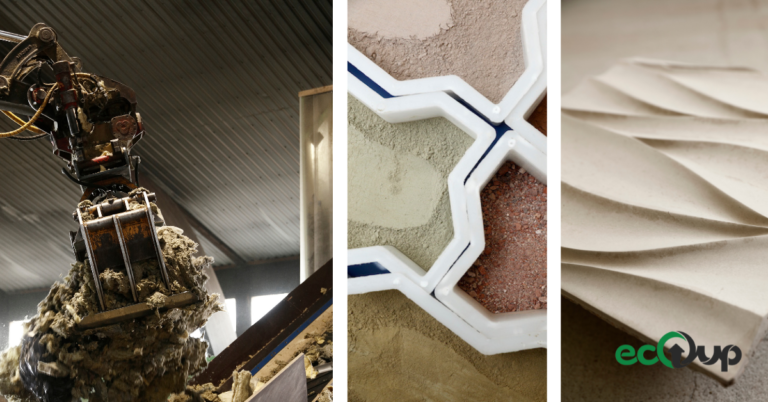In Europe alone, more than 500 million tons of construction and demolition waste is generated every year. What happens to that waste, is either it becomes landfill, or it is recycled to low grade aggregates with no potential for higher value re-use. At the same time, the use of virgin materials is high, and the construction industry produces 40% of global CO2 emissions.
Here at EcoUp are on the path of making a change, and we focus on two things:
- Developing energy-efficient methods and production technology for processing construction and demolition waste into clean, re-usable raw materials that replace virgin materials and reduce the carbon footprint without compromising quality and performance.
- Developing end-product specific chemical formulas for using these waste-based raw materials in new building products.
Let’s take a look at mineral wool
We start by cleaning the mineral wool waste from unwanted components such as plastic and wood. We then continue by crushing it to smaller sized grains. At this point the material already has cleanliness of 98%.
The real magic happens next – we take those small grains, and grind them through our process. As a result, we have very fine pulver, which we call the geopolymer base material.
Next the geopolymer base material is activated according to our formulas, which means that now it becomes a geopolymer. These geopolymers now act as environmentally friendlier substitutes for body materials, binders and fillers, and can be used for various types of products such as bricks, pavement stones, wall panels or plasters, for instance.
Pulverized base material or geopolymer?
Now in certain cases it may make sense to use merely the clean pulverized base material without any activators – if you want to replace 1/3 of cement in your products for instance. We do, however, see richer amount opportunities when the base material is geopolymerized. In this case, it is possible to build products which can be 100% of waste-based materials.
Why focus on both equipment and materials development?
In our opinion, when we’re dealing with waste, it is quite challenging to develop either or: The way the waste-based raw materials are used in end products – in essence their performance and quality criteria – ultimately define the processing of different waste fractions, hence defining how the equipment should be built. We consider it a must to understand the entire lifecycle from waste recovery to the end product to provide concrete, valuable solutions for our customers.
What’s the business?
There is of course a business aspect to this all as well, and it covers the value chain, take a look:
- Recycling industry operator: With our technology the recycling industry operators are now able to transform variety of waste fractions into higher value materials.
- Product manufacturers: with the new, higher value raw-materials the product manufacturers are able to substitute virgin materials and decrease their environmental footprint.
- Construction developers: In the end of the value chain, the construction developers are able to reduce the carbon footprint of the buildings and increase the compliancy against upcoming regulations such as the EU taxonomy.
If you have any questions, please contact:
Sini Rytky
Director of Business Operations


